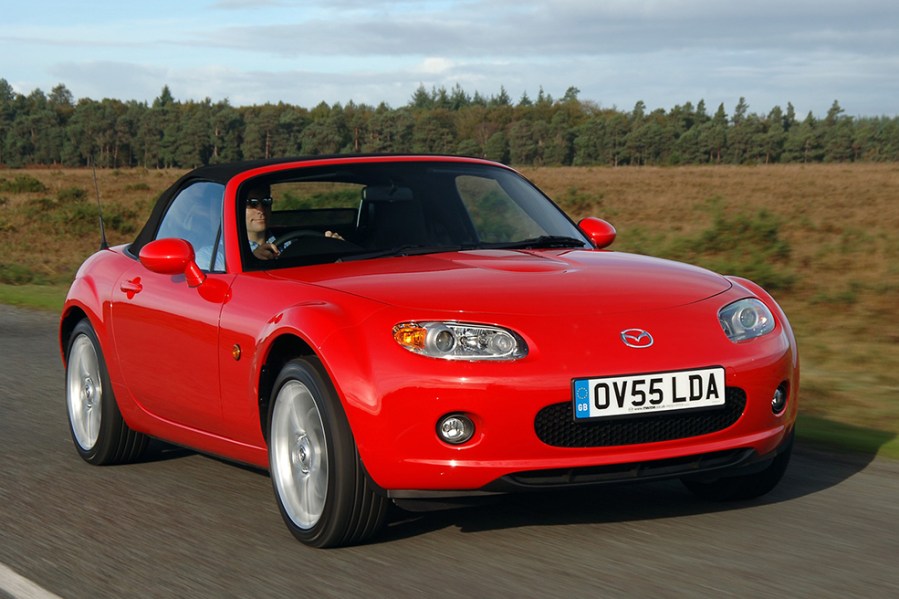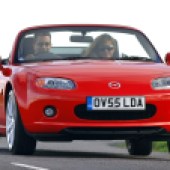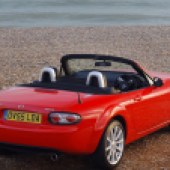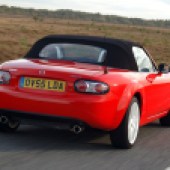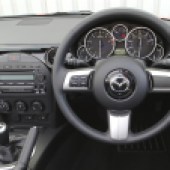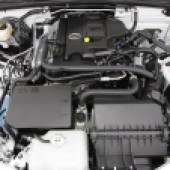The Mazda MX-5 NC (Mk3) brought hitherto unknown sophistication to the seminal modern-classic roadster. Here’s how to buy a great one
Words: Joe Miller
The ‘NB’ second generation Mazda MX-5 was evolutionary rather than revolutionary, modernising the interior and improving the driving experience and practicality mildly, but showing its age by the mid-2000s. Launched in 2005, the NC generation was an all-new model; Safety was improved thanks to numerous airbags and driver aids in the form of traction and stability control that could reduce and manage power in the event of lost grip to prevent the uninitiated crashing what may well have been their first rear-driven car.
Despite looking bigger than the MX-5 NB thanks to larger wheels, bulbous lights and flared arches, the NC remained a lightweight, compact sports car weighing just 45kg more than its predecessor, measuring just two inches longer and 1.6 inches wider. The mildly inflated dimensions aided the interior, which was granted extra space as well as equipment: options included satellite navigation, a semi-automatic paddle-shift gearbox and an electronic folding metal roof which, despite the perceived heaviness, adds just 36kg of weight.
The NC introduced more luxury and comfort to the formula and although some may argue that this ruins the purity of the MX-5, it does add more everyday liveability to the same fun driving experience that proved popular in the first two generations. The once-maligned MX-5 NC is now becoming the default choice for enthusiasts on a budget, with early cars available for similar money to the more basic NB – and far less than the original MX-5 NA.
Bodywork
Perhaps the most appealing ownership prospect of the third-generation MX-5 is their relative lack of rust. Unlike its forebears, the NC doesn’t suffer with chassis leg, arch or sill rot in any known capacity, even on the oldest UK cars. Any signs of structural rust on the bodywork or underneath therefore, probably indicates previous accident damage and/or bad bodywork repair. The low bonnet means stone chips are common, which can lead to corrosion and any light rusting inside the bonnet or bootlid is likely caused by the rubber seals wearing through the soft paint over time. This is easily rectified by sanding the corrosion back, painting it then covering with tape underneath the seal to prevent further abrasion.
Soft-top drains should be clear to prevent water ingress or rust creeping in, so look for damp on the parcel shelf or under the seats as signs that the drains are blocked. Numerous electrics are housed in the seats and underneath carpets, so a car with water ingress could be a nightmare of electrical gremlins if not caught early on. The plastic panel below the wipers should also be secured tightly, as it too can invite water leaks into the footwells.

Engine and transmission
The Mk3 MX-5 was offered with two engines: the 1.8-litre MZR L8-VE which was mated to a five-speed gearbox and produced 126bhp, or the 2.0-litre MZR LF-VE. The largest factory-fitted MX-5 engine, this unit offered 158bhp through a six-speed transmission. Both engines are durable, being relatively modern Japanese units, but listen carefully for a rumbling crankshaft at idle, particularly on 1.8-litre cars. This indicates the oil level being repeatedly low and not only means a rebuild in the engine’s future, but suggests poor maintenance elsewhere. If the owner hasn’t been checking and filling the oil correctly, what else has been neglected?
Oil changes should be done no later than every 8000 miles unless the car is in regular use, in which case 6000 mile intervals are recommended. On the subject of oil, blue smoke when driving can indicate worn piston rings and once again, that suggests the need for an engine rebuild. These cars are common enough that unless the car in question is otherwise perfect and well below market value, major engine work isn’t worth doing. If major problems rear their head, walk away.
A misfire when idling or accelerating is a common occurrence on NC MX-5s as early cars had thin and extremely fragile wiring to the coils, which can fray over time or get damaged during underbonnet maintenance. This can be rectified by a home mechanic or auto-electrician, but we’d recommend following this repair with new coils and spark plugs. Make sure the car’s price reflects this.
Switching to timing chains for the Mk3 meant the MX-5’s engines were now even more durable, but on early cars the timing chain tensioners are a known weak point. If the car has been well cared for and made it past around 70,000 miles, the tensioner has likely been replaced or upgraded but if there’s no evidence to suggest this, make enquiries. Both engines require a major service at 62,500 miles which should be done by a Mazda dealer – again, ask for proof.
The factory-supplied FL22 coolant should be good for up to 120,000 miles or ten years, but we’d advise changing yours upon purchase for peace of mind unless you’re buying a very late car. The coolant reservoir itself is prone to cracking, so check around the neck of the plastic reservoir for coolant residue. Replacements are common and if you want to smarten up your engine bay, MX5parts sells an aluminium expansion tank.
Like its predecessors, the MX-5 NC sports a precise, tactile gearchange regardless of which transmission it has. Both gearboxes, particularly the five-speed, have a stiffer shift when cold. The change should ease within a few miles but if you want to improve this long-term, Red Line MT gearbox oil is recommended by NC owners. Any rattling sounds or vibrations through the shifter could suggest someone has forced the transmission into gear aggressively when cold and potentially chipped a gear or damaged the synchromesh. Second-hand replacements are available under £200 and being a rear-drive car, the swap is easy enough for a home mechanic. If the differential appears to be whining or rumbling, particularly at low speeds, this indicates low differential oil. We’d recommend flushing and changing the engine, gearbox and diff oil on purchase.
Suspension, steering and brakes
MX-5 suspension has long struck a good balance between sportiness and suppleness and the NC was no different, but to maintain those characteristics, the suspension itself should be healthy. Anti-roll bar drop-links on Mk3s are usually worn out after 40,000 miles, slightly more on cars that primarily do motorway miles. Dampers have a service life of 30,000 miles and will give the car a spongey, slightly wallowy feeling if past their best.
The factory offered optional Eibach lowering springs, which are blue and drop the height by 30mm. It’s a relatively rare option, but if you’re looking to lower and stiffen the ride and handling, all manner of aftermarket companies can cater for NC MX-5s with sportier springs and dampers.
The bigger wheels on the Mk3 mean wider tyres and that makes them alignment sensitive: the car should be eager, but not spiky and it shouldn’t tramline. The alignment is easily knocked out, however, so keep an eye out for odd tyre wear. Tyres can be transformative to the driving experience – enthusiasts recommend Nankang’s semi-slick NS2-R or AR-1 offerings, but such tyres aren’t advised for road cars or wet conditions, for which the Kumho KH31 comes highly recommended.
MX-5s of all generations are infamous for seizing brake callipers, so on a test drive, try a few hard stops and check that the car pulls up in a straight line. Also inspect the discs for signs of scoring and look for comparable pad wear on both sides. £30 buys you a brand new calliper and once installed, we’d recommend regularly moving the car to prevent seizing and parking with the handbrake off if possible.
Interior, trim and electrics
Electrics are often the trouble area on cars of this era; the optional folding metal roof is a complex, costly item and should work perfectly. The operation should be smooth, quiet and take just 12 seconds to close or open. Any untoward noises or noticeably slow operation should be viewed with caution.
Earlier examples used plastic gears which are fragile and difficult to replace. Most will have had better quality replacements by now, but inspect the mechanism as much as possible, particularly on higher-mileage cars.
Dashboard warning lights can be triggered by a low battery or following a jump-start but the DSC warning, for example, can be deactivated by turning the steering lock to lock unless something else is awry. However, with warning lights now an MoT failure, it pays to be fairly confident you can rectify any persistent lights – perhaps use an OBD2 code-reader for diagnosis.
The electric window switches can break and are a fiddly job to change, so make sure they operate faultlessly and one-touch operation on the driver’s window works as it should. The seatbelt reels get slack with age, the driver’s obviously being the first to go – yank hard on the belts a few times and check them on the emergency stops to test the brakes, make sure the belts tense and release as they should. Finally, make sure you get both keys with the car and that both will lock, unlock and start it as replacement keys can cost £150–200 and have to be coded by Mazda.
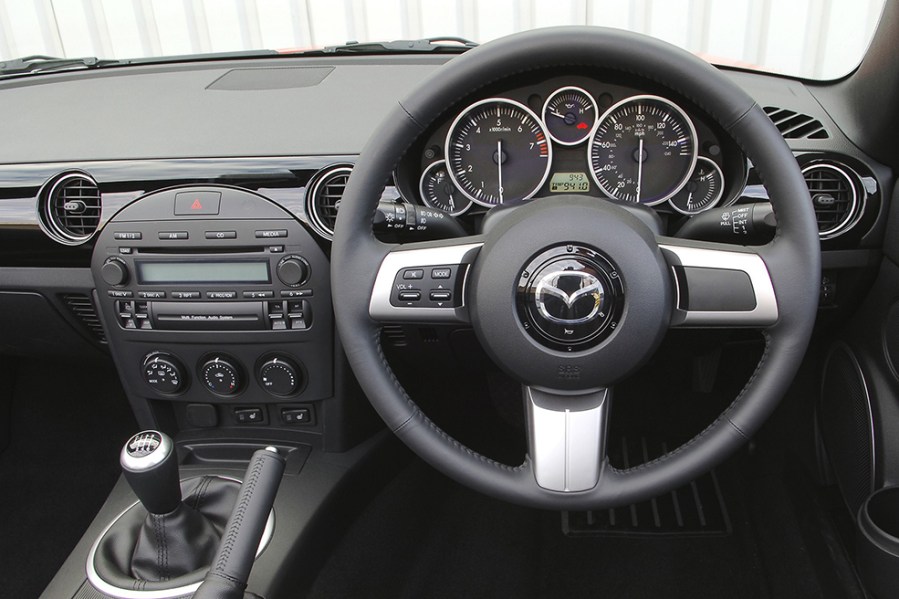
Mazda MX-5 NC (Mk3): our verdict
Three years ago, the NC MX-5 would have had no place in the classic car world – too modern, too complex and too expensive for most of us. Today, however, it has huge appeal, combining the back-to-basics, fun driving experience we know and love from the first two generations of MX-5, but adding enough creature comfort and luxury that long journeys don’t seem intimidating and unless you need four seats, you could use one as your daily driver. What’s more, prices now start at under £2000 which represents fantastic value.
The 2.0-litre cars benefit from better performance, the six-speed gearbox for better economy and motorway cruising and a limited-slip differential. We wouldn’t discourage anyone from buying a 1.8, however and if you enjoy wringing its neck for every drop of performance, you’ll prefer it. Most limited editions extend to wheels and paint, so usually aren’t worth the premium. The electric metal roof sounds appealing, but the enormous complexity and potential for issues might put some off and whilst it’s only a small weight gain, rather misses the point of the MX-5.

